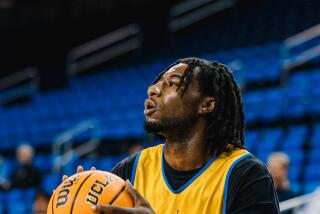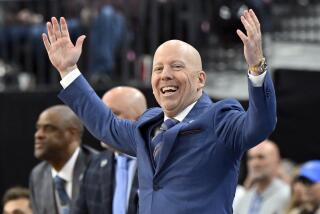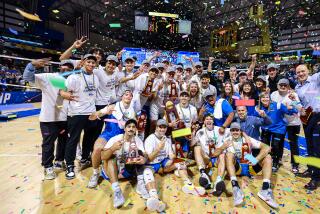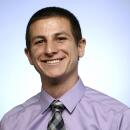Twenty years ago, Tyus Edney saved UCLA’s last NCAA title run
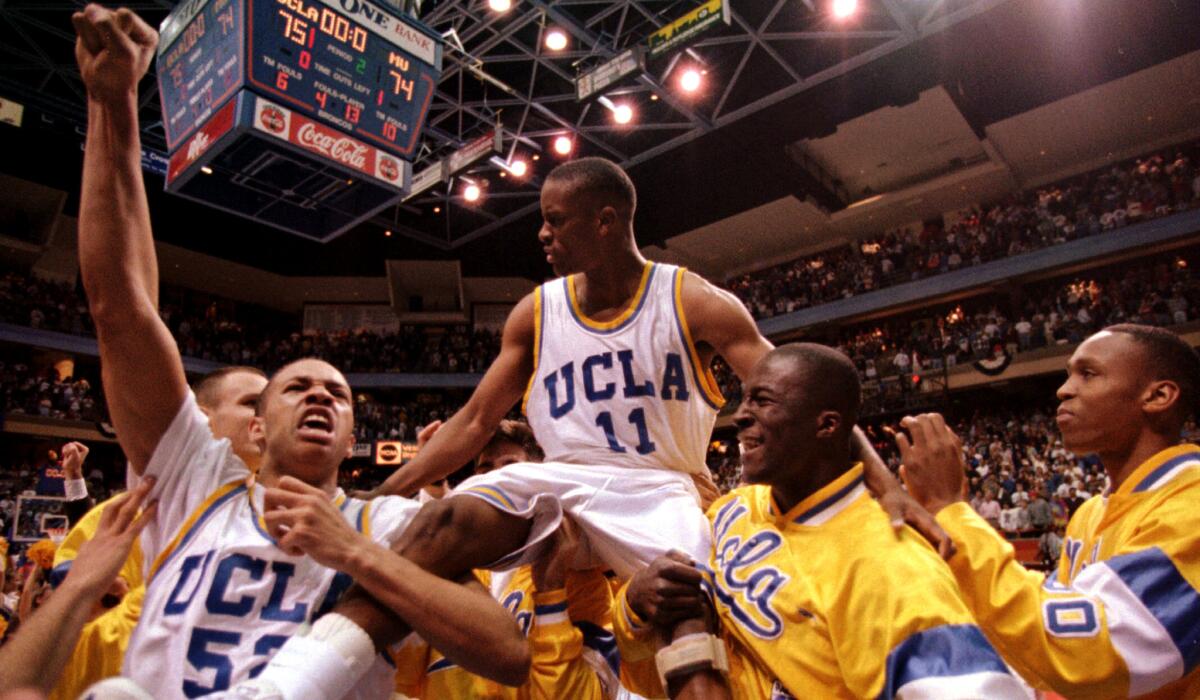
There were 4.8 seconds left, UCLA trailed by a point, and the members of the Bruins’ 1995 men’s basketball team knew it was the kind of March moment when legacies are made.
They were desperate for a national championship. The program, once the gold standard in college basketball, had not won one in 20 years.
Now, in an NCAA tournament second-round game at Boise, Idaho, everything they did, Missouri countered.
“I remember thinking, could this actually be it?” forward Ed O’Bannon said. “Are we going out like this?”
UCLA coach Jim Harrick called a timeout, and immediately O’Bannon yelled, “Give me the damn ball! I want the ball!”
He was not even back to the bench yet, but O’Bannon, shy by nature, had become the team’s vocal leader and emotional core in his senior season.
The wounds from his junior year, when UCLA had been ranked as high as No. 1 before being shocked in an NCAA first-round loss to Tulsa, were still raw. After that game, O’Bannon said, he decided he was tired of losing. He knew the team had to get tougher, so he got tougher on them.
When practice had started in the fall, he’d play dirty or ride players whom he considered talented but soft. Freshman guard Toby Bailey was a frequent target. When Bailey got close in a scrimmage, O’Bannon would hit him. He thought Bailey could be great if he could toughen him up.
But now, with the season on the line, O’Bannon didn’t want to depend on anyone else. He wanted the ball.
“Sit down and shut up,” Harrick told him. And O’Bannon did.
Ordinarily, Harrick didn’t micromanage. This time, though, he had an idea, and he wanted the Bruins to stick to his plan.
“Tyus, you get the ball,” Harrick said in the team huddle. “You take it the length of the floor, take it to the rim because they’re not going to foul you, and you see what happens.”
Tyus Edney, a senior like O’Bannon, wasn’t big, but he was fast. “Like the roadrunner,” Harrick said. “Zip-zip-zip!”
Edney had only seconds to cover the length of the floor, but Harrick once had seen Lakers great Jerry West go three-quarters of the court in three seconds to beat the Boston Celtics. After that, he ran every team he coached through a drill: full court in four seconds.
“We had practiced that,” Harrick said. “I knew what he could do. I didn’t have any hesitation.”
To be sure, Harrick said, he walked out on the floor with his arm around Edney. “Tyus,” he said, “do you have a crystal-clear understanding of what I said?”
Edney: “Yes, you want me to shoot the ball.”
Harrick: “Absolutely, I want you to shoot that ball.”
At the baseline, Cameron Dollar prepared to inbound the ball.
Dollar, a sophomore, was a promising point guard and Edney’s backup. Before the season, when Edney sprained his knee and couldn’t practice for two weeks, Dollar impressed during his absence. Edney would watch near the coaches, Harrick said, “and we’d say, ‘Boy, Dollar’s not bad. Dollar’s pretty good. Dollar’s doing a good job.’ ”
It wore on Edney. His first practice back, Harrick said, “he absolutely destroyed Cameron Dollar.”
But the competition would prove invaluable later.
From the baseline, Dollar’s pass hit Edney in stride. He took three dribbles with his left hand to reach midcourt, where, Edney said, he stole a glance up.
Near the basket, Edney saw Bailey. On the right side, near the three-point line, was freshman forward J.R. Henderson, whom Harrick regarded as irreplaceable because he could play all five positions.
Edney surveyed the court, but he knew what Harrick wanted.
“I knew I couldn’t get stopped,” he said.
Edney passed the midcourt stripe — zip-zip — and dribbled behind his back to turn his defender’s hips.
He took three more dribbles with his right hand into the paint.
Edney was 5 feet 10 — “just a little guy,” Harrick said — but the coach can’t remember a shot of his getting blocked.
Henderson’s defender slid down and raised his arms. Edney pushed off with his left leg, extended the ball out with his right and let go, inches above the block attempt.
“It was like in slow motion,” Bailey said at the time.
The games to follow wouldn’t challenge UCLA like this. The Bruins beat Mississippi State, Connecticut and Oklahoma State to reach the national championship game.
In the title game, against Arkansas at the Seattle Kingdome, O’Bannon took over. Senior center George Zidek and sophomore Charles O’Bannon, Ed’s brother, stepped up. Bailey blocked a shot so hard the shooter fell down, and Bailey stood over him for longer than necessary, and Ed O’Bannon said he felt proud, like a father.
“It felt like the plan worked,” he said.
Edney, who’d injured his wrist against Oklahoma State, would try to play in the title game but left after three minutes. But Dollar, already hardened, was ready to replace him. He had eight assists.
Ed O’Bannon would finish with 30 points, 17 rebounds and the Final Four’s most-outstanding-player award. Bailey scored 26 points.
And UCLA beat the Razorbacks, 89-78, for the Bruins’ 11th national championship, and first since 1975, when John Wooden retired after his 10th title in 12 seasons.
After that, Edney said, it looked as if UCLA were back. It had talent, coaching and promising recruits.
“I just thought that they would get another one for sure,” Edney said.
Who really knew? Turns out, it’s been 20 years since UCLA’s last NCAA men’s basketball championship.
After the 1995-96 season, Harrick would be gone, fired over what school administrators said was ethical misconduct.
The drought wouldn’t have happened, Harrick said recently, “if I’d have stayed.”
But back in 1995, the ball was in the air in what Harrick said was the defining moment of all their careers.
Six players from that UCLA team went on to the NBA, though none stuck there for too long. But together, they clicked.
Edney’s shot banked off the glass and dropped in.
Edney leaped. His teammates mobbed him. The Bruins had won, 75-74, and they would not lose again that season, finishing 31-2.
It would become a signature March moment, replayed over and over as a highlight entering every tournament since.
More to Read
Go beyond the scoreboard
Get the latest on L.A.'s teams in the daily Sports Report newsletter.
You may occasionally receive promotional content from the Los Angeles Times.
